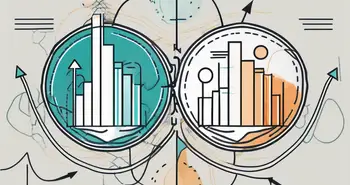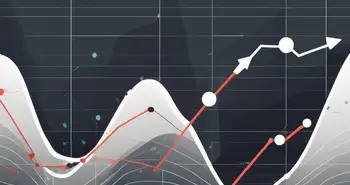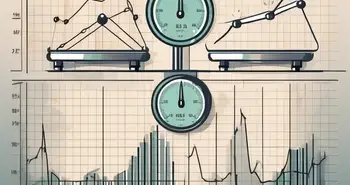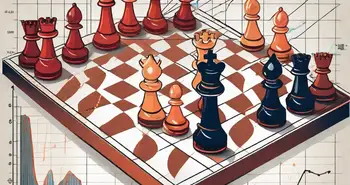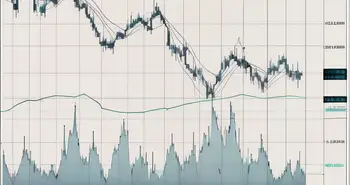What is Fractal Trading?

Fractal trading is a fascinating approach that allows traders to analyze price patterns and make informed decisions. In this ultimate guide, I will take you through the ins and outs of fractal trading, from understanding the basics to leveraging powerful tools and implementing winning strategies. So, let's start our journey into the world of fractal trading!
Understanding Fractal Trading
The Basics of Fractal Trading
Fractal trading is based on the concept of self-similar patterns that repeat at various scales. These patterns can be found in financial markets, and by identifying them, traders gain valuable insights into future price movements.
One fascinating aspect of fractal trading is how these patterns can be seen not only in price charts but also in other market data such as volume and volatility. This holistic view enables traders to make more informed decisions based on a comprehensive analysis of market behavior.
As a fractal trader, I've learned that these patterns occur on all timeframes, from minutes to months, making them applicable to various types of trading, including day trading and long-term investing.
The Importance of Fractal Trading in Financial Markets
Fractal trading provides a unique perspective on the market, helping traders spot turning points and better understand market dynamics. By analyzing fractal patterns, traders can anticipate trends, reversals, and breakouts.
Moreover, the concept of fractals extends beyond technical analysis and can be applied to risk management strategies. Traders can use fractal principles to determine optimal stop-loss levels, position sizes, and overall portfolio allocation, enhancing their risk-adjusted returns.
Throughout my trading journey, I've witnessed firsthand how using fractal analysis has enhanced my decision-making process, allowing me to navigate volatile markets with confidence and precision.
The Principles of Fractal Trading
Fractal trading is a fascinating approach that involves identifying repetitive patterns in financial markets. These patterns, known as fractals, are formed by a series of five consecutive bars, with the middle bar displaying the highest high or lowest low. Traders keen on mastering this strategy pay close attention to these formations as they can signal potential reversals or continuations in the prevailing trend.
Delving deeper into the world of fractal trading, it becomes evident that spotting these intricate patterns provides traders with a unique perspective on market dynamics. By recognizing fractal patterns, traders can enhance their understanding of market structure and make well-timed decisions regarding their entries and exits, ultimately leading to more profitable trades.
Identifying Fractal Patterns
Fractals are formed by a series of five consecutive bars, with the middle bar showing the highest high or lowest low. When this pattern occurs, it indicates a potential reversal or continuation of the prevailing trend.
By spotting fractal patterns, traders gain valuable insights into the market's structure and can time their entries and exits with greater accuracy.
Interpreting Fractal Signals
Understanding the signals offered by fractals is essential for successful trading. When a fractal with a higher high or lower low appears, it signals a potential buy or sell opportunity. However, it's crucial to remember that fractals should always be confirmed by other technical indicators or price action signals.
As an expert, let me share a personal story. Once, I witnessed a fractal pattern forming accompanied by a strong bullish divergence on the relative strength index (RSI). Recognizing this high-probability setup, I entered a long position and rode the subsequent uptrend, locking in significant profits.
Tools for Fractal Trading
Essential Software for Fractal Trading
To effectively analyze and trade fractals, traders need access to reliable charting software. Platforms such as MetaTrader and TradingView offer intuitive and feature-rich charting tools, allowing you to easily identify fractal patterns.
Personally, I find TradingView's user-friendly interface and extensive library of technical indicators invaluable for my fractal trading strategies.
Moreover, it's important to note that the real-time data and customizable alerts provided by these platforms can significantly enhance your ability to react swiftly to market changes, a crucial aspect of successful fractal trading.
Utilizing Fractal Indicators
Fractal indicators, such as the Fractal Chaos Bands and the Alligator indicator, can provide valuable confirmation signals for fractal patterns. These indicators help identify potential breakouts, trend reversals, and areas of support and resistance.
By combining these indicators with proper risk management, I've been able to increase my trading accuracy and consistently achieve profitable results.
Furthermore, understanding the intricacies of how these indicators interact with each other and with price action is key to unlocking their full potential in your trading strategy. This deeper comprehension can lead to more nuanced decision-making and improved overall performance in the fractal trading landscape.
Strategies for Successful Fractal Trading
Timing Your Trades with Fractals
Timing is everything in trading, and fractals can be powerful tools for determining optimal entry and exit points. By waiting for fractal confirmations, traders can avoid false signals and increase their probability of success.
One effective strategy I employ is to wait for a fractal pattern to form and then enter a trade when the price breaks above the fractal high or below the fractal low. This approach has helped me capture substantial profits in trending markets.
Another key aspect to consider when utilizing fractals in trading is the concept of fractal dimension. Fractal dimension can provide traders with insights into the market's structure and help identify potential turning points. By understanding the fractal dimension of a price series, traders can adapt their strategies to changing market conditions more effectively.
Combining Fractals with Other Trading Techniques
Fractal trading works exceptionally well when combined with other technical analysis techniques. By integrating fractal analysis with indicators like moving averages, trendlines, and Fibonacci retracements, traders can further enhance their decision-making process.
Personally, I've found that combining fractal analysis with candlestick patterns and trendline breakouts provides a robust framework for both swing trading and day trading.
Moreover, incorporating risk management strategies such as setting stop-loss orders based on fractal levels can help traders protect their capital and minimize potential losses. This risk management approach, when combined with fractal analysis, creates a comprehensive trading plan that accounts for both market dynamics and individual risk tolerance levels.
Risks and Rewards of Fractal Trading
Managing Risks in Fractal Trading
Like any trading approach, fractal trading comes with its own set of risks. False signals and unpredictable market conditions can test even the most experienced traders. To manage these risks, it's crucial to implement proper risk management techniques, including setting stop-loss orders and using appropriate position sizing.
As a seasoned fractal trader, I always emphasize the importance of disciplined risk management to protect capital and preserve long-term profitability.
One key aspect of risk management in fractal trading is understanding the concept of market correlation. By diversifying your trades across different markets or assets, you can reduce the impact of a single market event on your overall portfolio. This approach helps to mitigate risks and safeguard your investments against sudden market fluctuations.
Maximizing Profits with Fractal Trading
While risks exist, the potential rewards of fractal trading are immense. By accurately identifying and interpreting fractal signals, traders can capture significant price movements and generate consistent profits.
My personal advice is to focus on continuous learning and practice. Identify your strengths and weaknesses as a trader, hone your skills, and remain adaptable in an ever-changing market environment.
Another strategy to maximize profits in fractal trading is to incorporate advanced technical analysis tools. Utilizing indicators such as moving averages, Fibonacci retracements, and trendlines can provide valuable insights into market trends and potential price reversals. By combining these tools with your fractal trading strategy, you can enhance your decision-making process and improve the overall profitability of your trades.
FAQ
What is fractal trading?
Fractal trading is a strategy that involves identifying self-similar patterns in financial markets to predict price movements. These patterns can occur on various timeframes and help traders spot potential trend reversals and breakouts.
How do I identify fractal patterns?
Fractal patterns consist of five consecutive bars, with the middle bar displaying the highest high or lowest low. By recognizing these patterns, traders can gain valuable insights into market structure and make informed trading decisions.
Why should I use fractal indicators?
Fractal indicators, such as the Fractal Chaos Bands and the Alligator indicator, provide confirmation signals for fractal patterns. These indicators can help traders validate potential breakouts, trend reversals, and areas of support and resistance.
What are the risks of fractal trading?
Fractal trading, like any trading strategy, carries risks. False signals and unpredictable market conditions can lead to losses. To manage these risks, traders should implement proper risk management techniques, such as setting stop-loss orders and utilizing appropriate position sizing.
How can I maximize my profits with fractal trading?
To maximize profits, it's essential to accurately identify and interpret fractal signals. By combining fractal analysis with other technical analysis techniques, traders can increase their trading accuracy. Additionally, focusing on continuous learning, disciplined risk management, and adaptability will contribute to long-term profitability.
Now armed with a comprehensive understanding of fractal trading, it's time to incorporate this powerful strategy into your trading arsenal. Remember, practice, patience, and adaptability are key to achieving success in the dynamic world of financial markets.
Fractal trading has gained popularity among traders due to its ability to capture market trends and reversals. The concept of fractals, derived from chaos theory, suggests that patterns repeat themselves at different scales. This idea is applied to financial markets, where traders look for repeating patterns that can indicate potential price movements.
One of the advantages of fractal trading is its versatility. Fractal patterns can be identified on various timeframes, from short-term charts like 5-minute or 15-minute intervals to longer-term charts like daily or weekly intervals. This flexibility allows traders to adapt their strategies to different market conditions and time horizons.
When identifying fractal patterns, traders pay close attention to the middle bar, which represents the highest high or lowest low in the pattern. This bar serves as a key level of support or resistance, indicating potential price reversals. By understanding the significance of this middle bar, traders can make more informed decisions about entering or exiting trades.
Fractal indicators play a crucial role in confirming the validity of fractal patterns. The Fractal Chaos Bands, for example, provide visual representation of potential support and resistance levels, helping traders identify areas of interest. The Alligator indicator, on the other hand, assists in determining the direction of the trend, further enhancing the accuracy of fractal-based trading strategies.
While fractal trading can be a profitable strategy, it is important to acknowledge the risks involved. False signals are a common occurrence in financial markets, and relying solely on fractal patterns may lead to losses. Traders should always consider other technical indicators, market conditions, and risk management techniques to validate their trading decisions.
By incorporating proper risk management techniques, such as setting stop-loss orders and utilizing appropriate position sizing, traders can mitigate the risks associated with fractal trading. Additionally, continuous learning and adaptability are essential for long-term profitability. Markets are dynamic, and staying updated with new developments and adjusting strategies accordingly is crucial for success.
Now that you have a comprehensive understanding of fractal trading, it's time to put your knowledge into practice. Start by analyzing historical price data, identifying fractal patterns, and testing your strategies in a simulated trading environment. Remember, practice makes perfect, and with dedication and discipline, you can harness the power of fractal trading to achieve your financial goals.
Ready to take your fractal trading to the next level with a platform that's as innovative as your strategies? Discover Morpher.com, the revolutionary trading platform that leverages blockchain technology to offer zero fees, infinite liquidity, and a multitude of markets including stocks, cryptocurrencies, and more. With features like fractional investing, short selling without interest fees, and up to 10x leverage, Morpher is designed to empower traders like you. Experience the future of trading with the safety and control of a non-custodial Morpher Wallet. Sign Up and Get Your Free Sign Up Bonus today, and join the community of traders who are reshaping the world of investing with Morpher.

Disclaimer: All investments involve risk, and the past performance of a security, industry, sector, market, financial product, trading strategy, or individual’s trading does not guarantee future results or returns. Investors are fully responsible for any investment decisions they make. Such decisions should be based solely on an evaluation of their financial circumstances, investment objectives, risk tolerance, and liquidity needs. This post does not constitute investment advice.

Painless trading for everyone
Hundreds of markets all in one place - Apple, Bitcoin, Gold, Watches, NFTs, Sneakers and so much more.

Painless trading for everyone
Hundreds of markets all in one place - Apple, Bitcoin, Gold, Watches, NFTs, Sneakers and so much more.


